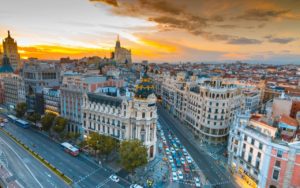
Summary:
There’s arguably never been a better time to visit Madrid. Prices are still relatively low, but the economic and political turmoil of the past decade has helped spur an outpouring of creativity and enterprise in Spain’s golden capital. Experimentally minded locals have enlivened the city’s aging mercados and turned its derelict factories into thriving art centers.
Friday
There’s probably no dish more emblematic of Madrid than the bocadillo de calamares, the simple wedding of crusty baguette and squid fried in olive oil that, when done right, is extremely satisfying. Grab a standing spot at one of the bars at the edges of the grand, arcaded Plaza Mayor to enjoy a classic, under-three-euro (or about $3.60) version of the sandwich, washed down with a caña, or small beer.
One of Madrid’s most of-the-moment shopping areas is Las Salesas, the leafy downtown neighborhood running from Chueca to Salamanca.
Think “Happiness” with a Spanish accent), which the local designer María Beltrán Joyas filled with a tastefully eclectic assortment of accessories, candles, perfume and jewelry, much of it of her own design.
Tipping and taking photos are still strictly forbidden remnants of the bar’s time as a Republican haunt during the Spanish Civil War — and the only drink on offer is sherry: exquisite, honey-hued and poured from hulking oakwood casks, same as it ever was. Another fetching Madrileño relic, Bar Cock has been open since 1921 in a cavernous former brothel decked out like an English gentlemen’s club. With its well-poured cocktails, pleasantly stagey interior, and whiff of debauchery, it’s easy to see why it’s been a late-night spot for everyone from Frank Sinatra to Pedro Almodóvar to Francis Bacon, who according to bar legend came here for his final martini.
Saturday
Opened last April in a small red-brick atelier, Pum Pum Café is already popular with bohemian-inflected locals, who flock here weekends for the brunch offerings. Try the “Club Mix”: eggs Benedict with avocado, a fresh croissant, organic granola with fruit and yogurt, a mimosa or fresh-squeezed orange juice and an espresso drink or artisanal pour-over filter coffee, all for 10 euros.
Since opening last summer in upmarket Salamanca, Amazonico, an opulent jungle-inspired restaurant by the gastronomic power couple behind El Paraguas and Ten con Ten, has become the city’s latest “it” dining spot. Hanging palms, lush jungle prints, and a circular sushi bar topped with exotic fruits and a luminous stuffed peacock — the work of the Catalan interior designer Lázaro Rosa-Violán — create an aptly flamboyant backdrop for Madrid’s fat cats and debutantes.
Sunday
El Rastro, Spain’s largest flea market, has been unfurling across La Latina neighborhood for half a millennium. Named for the trail of blood left by slaughtered cattle on the way to the tanneries, the teeming market offers everything from vintage furs and antiquaria to mismatched silverware, craft items, hand-me-down curios, synthetic flamenco frocks, and midcentury modern furniture.
Lodging
Set in the central Alonso Martínez neighborhood, Urso Hotel & spa is a chic boutique property in a restored early 20th-century palace replete with marble stairs, a wrought-iron balustrade and stained-glass windows. Doubles start at 170 euros.






